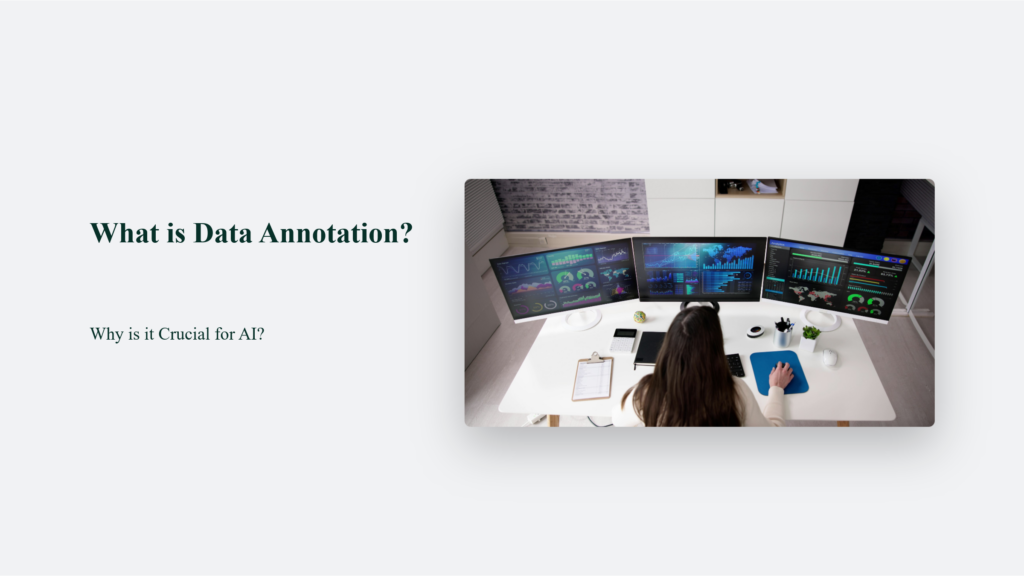In the ever-evolving landscape of artificial intelligence and machine learning, one term that consistently emerges as a cornerstone is “data annotation.” But what is data annotation, and why is it so crucial?
This article delves deep into data annotation, exploring its significance, methodologies, and future directions. By the end, you’ll have a thorough understanding of this essential process and how it powers the AI systems of today and tomorrow.

What is Data Annotation?
Data annotation labels or tags raw data with relevant information, making it understandable for machine learning algorithms. This step is indispensable for training models that can perform tasks ranging from image recognition to natural language processing. Without high-quality annotated data, even the most sophisticated algorithms would struggle to make sense of the vast amounts of unstructured data available.
Why Data Annotation Matters?
Data annotation is the backbone of artificial intelligence and machine learning, transforming raw data into structured, meaningful information that algorithms can understand and learn from. Just as a child needs labeled examples to learn and recognize animals, machine learning models rely on annotated data to make accurate predictions and decisions.
The Power of Annotated Data
Imagine a vast collection of images, texts, or audio files. To the human eye, these data points are easily distinguishable and understandable. However, to a machine learning algorithm, they are nothing more than a sea of unstructured information. It is where data annotation comes into play.
Data annotation involves adding labels, tags, or metadata to raw data, providing context and meaning that machines can comprehend. For instance, in an image recognition task, data annotators might draw bounding boxes around objects and label them accordingly (e.g., “car,” “pedestrian,” “traffic light”). This process transforms the raw image data into a structured format, enabling the machine learning model to learn the distinguishing features of each object.
Enabling Machine Learning Success
The quality and accuracy of annotated data directly impact the performance of machine learning models. A model trained on poorly annotated data will need help to make accurate predictions or decisions, leading to subpar results and potential failures in real-world applications. On the other hand, high-quality annotated data acts as a solid foundation for machine learning success.
By learning from accurately labeled examples, models can better understand patterns, relationships, and context within the data. It enables them to generalize their knowledge and make informed predictions on new, unseen data.
Adapting to Unique Domains
Data annotation also plays a crucial role in adapting machine learning models to specific domains or industries. Each field has its own unique terminology, challenges, and nuances that must be captured in the annotated data.
For example, annotating medical images with precise labels for anatomical structures or abnormalities is essential for training models to assist in diagnosis and treatment planning.
Similarly, annotating video frames with labels for pedestrians, vehicles, and road signs in autonomous driving enables models to navigate complex environments safely.
By tailoring the annotation process to the specific needs of each domain, data annotation ensures that machine learning models can effectively tackle industry-specific challenges and deliver accurate results.
Fueling AI Innovation
Data annotation is essential for training machine learning models and fueling innovation in artificial intelligence. The demand for high-quality annotated data will only grow as AI advances and finds applications across various industries.
From natural language processing and sentiment analysis to object recognition and autonomous systems, data annotation underpins the development of cutting-edge AI technologies.
By investing in robust data annotation processes and tools, organizations can unlock AI’s full potential and drive transformative changes in their respective fields.
The Multifaceted World of Data Annotation
Data annotation is not a one-size-fits-all process. It encompasses various techniques and methodologies tailored to specific data types and applications. Here are some of the most common forms of data annotation:
Text Annotation
Text annotation involves adding labels to text data to identify entities, sentiments, or other relevant information. It can include:
- Named Entity Recognition (NER): Identifying and classifying entities such as names, dates, and locations within a text.
- Sentiment Analysis: Determining the sentiment expressed in a text, whether positive, negative, or neutral.
- Part-of-Speech Tagging: Labeling words with their corresponding parts of speech, such as nouns, verbs, and adjectives.
Image Annotation
Image annotation is the process of labeling images to identify objects, boundaries, and other features. This is crucial for applications like autonomous driving and medical imaging. Common techniques include
- Bounding Boxes, which involve Drawing rectangles around objects to identify their location.
- Semantic Segmentation: Label each pixel in an image with a class to understand the context.
- Keypoint Annotation: Marking specific points of interest within an image, such as facial landmarks.
Audio Annotation
Audio annotation involves labeling audio data to identify speech, sounds, or other relevant features. It is essential for applications like speech recognition and audio classification. Techniques include:
- Transcription: Converting spoken language into written text.
- Speaker Identification: Identifying and labeling different speakers within an audio clip.
- Sound Classification: Labeling different sounds, such as music, speech, or noise.

The Role of Large Language Models (LLMs) in Data Annotation
Consistency Across Large Datasets
One key advantage of using LLMs for data annotation is their ability to ensure consistent annotations across extensive datasets. Maintaining consistency can be a significant challenge in traditional manual annotation, especially when dealing with large volumes of data and multiple annotators.
Human annotators may have varying interpretations, biases, or levels of expertise, leading to consistency in the labeled data. On the other hand, LLMs can be trained on vast amounts of data and fine-tuned to adhere to specific annotation guidelines.
Once trained, these models can consistently apply the same criteria and rules across the entire dataset, ensuring high uniformity in the annotations. This consistency is crucial for training accurate and reliable machine learning models, as inconsistencies in the training data can lead to biased or inaccurate predictions.
Scalability for Large-Scale Projects
Another significant benefit of LLMs in data annotation is their scalability. As the demand for annotated data grows, traditional manual annotation methods need help keeping pace. Annotating large datasets by hand is an incredibly time-consuming and resource-intensive process, often requiring teams of trained annotators to work for extended periods.
LLMs offer a scalable solution to this challenge because they can process and annotate vast amounts of data rapidly. These models can handle datasets of virtually any size, from a few thousand to millions of examples, making them ideal for large-scale projects.
By automating the annotation process, LLMs can significantly reduce the time and cost associated with manual annotation, enabling organizations to scale their data annotation efforts to meet the growing demands of AI and machine learning.
Adaptability to Specific Domains
A third key advantage of LLMs in data annotation is their adaptability to specific domains. While pre-trained LLMs like GPT-4 have a broad knowledge base, they can be further fine-tuned to specialize in particular areas or industries. This fine-tuning process involves training the model on domain-specific data, allowing it to learn the nuances, terminology, and patterns unique to that field.
For example, an LLM fine-tuned for the medical domain would be able to accurately annotate medical records, identifying key information such as diagnoses, treatments, and medications. Similarly, an LLM adapted for the legal industry could effectively annotate legal documents, recognizing relevant entities, clauses, and provisions.
By tailoring LLMs to specific domains, organizations can significantly improve the accuracy and relevance of their annotated data, leading to better-performing machine-learning models.
Challenges and Solutions in Data Annotation
Despite its importance, data annotation is fraught with challenges. These include:
High Costs and Labor Intensity
Manual data annotation is time-consuming and expensive. Annotators need to be trained, and the process often requires multiple rounds of review to ensure accuracy.
Solution: Automating the annotation process with LLMs can significantly reduce costs and speed up the process. For instance, using semi-supervised learning techniques, as demonstrated in a case study on whole-plant corn silage, can enhance efficiency while maintaining high-quality annotations.
Subjectivity and Inconsistency
Different annotators may interpret data differently, leading to inconsistencies in the annotations.
Solution: Implementing clear annotation guidelines and using LLMs to ensure consistency can mitigate this issue. For example, in image annotation, using predefined templates and automated tools can help maintain uniformity.
Data Privacy and Security
Handling sensitive data, such as medical records, requires stringent privacy and security measures.
Solution: Employing secure annotation platforms and anonymizing data can help protect sensitive information. Using LLMs that operate within secure environments can further enhance data security.
Future Directions in Data Annotation
The field of data annotation is continuously evolving, with new technologies and methodologies emerging to address existing challenges. Here are some trends to watch:
Enhanced Automation with AI
As AI technologies advance, we can expect even greater automation in data annotation. It includes using more sophisticated LLMs and other AI tools to handle complex annotation tasks.
Integration with Augmented Reality (AR) and Virtual Reality (VR)
AR and VR technologies can provide immersive environments for data annotation, particularly in fields like medical imaging and autonomous driving. These technologies can enhance the accuracy and efficiency of the annotation process.
Crowdsourcing and Collaborative Annotation
Leveraging the power of crowdsourcing and collaborative platforms can help scale data annotation efforts. Organizations can achieve faster and more diverse annotations by involving a larger pool of annotators.
The Bottom Line:
In conclusion, data annotation is a critical component of the AI and machine learning ecosystem. By understanding its importance, methodologies, and future directions, organizations can harness the power of annotated data to build more accurate and efficient models.
Whether you’re a seasoned professional or new to the field, staying informed about the latest trends and technologies in data annotation will help you stay competitive in this rapidly evolving landscape.
Frequently Asked Questions:
How do large language models (LLMs) help in data annotation?
LLMs like GPT-4 can automate many aspects of the data annotation process, ensuring consistency, scalability, and adaptability.
What are the future trends in data annotation?
Future trends include enhanced automation with AI, integration with AR/VR, and collaborative annotation platforms.




